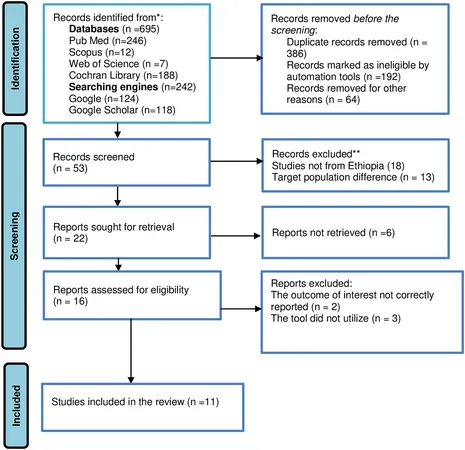
Unveiling the Alarming Prevalence of Metabolic Syndrome Among Type 2 Diabetics in Ethiopia: Insights from a Comprehensive Study
2025-01-10
Author: Ming
Recent research highlights an alarming prevalence of metabolic syndrome among type 2 diabetic patients in Ethiopia, drawing from various validated diagnostic criteria such as the International Diabetes Federation (IDF), the National Cholesterol Education Program Adult Treatment Panel III (NCEP-ATP III), and others. This systematic review and meta-analysis compiled data from a multitude of international databases including PubMed, Scopus, Web of Science, and Google Scholar to shed light on the determinants influencing metabolic syndrome in this high-risk population.
The examination began with a meticulous filtering process, where studies published between 2014 and 2024 were scrutinized. Eligible studies included observational research documenting the prevalence of metabolic syndrome among adults aged 18 and above diagnosed with type 2 diabetes. A rigorous selection led to the review of 695 potential articles, with only 11 ultimately meeting the stringent inclusion criteria for this analysis.
The findings are startling: The pooled prevalence of metabolic syndrome among these diabetic patients is estimated at a staggering 54.56%. Delving deeper revealed that this prevalence varies significantly across regions, with the Amhara region reporting the highest rates. Such disparities can be attributed to a mix of socio-cultural factors and access to healthcare services affected by regional conditions, including ongoing socio-political challenges.
In terms of methodology, three independent researchers evaluated the quality of studies using a standardized tool, ensuring that only those deemed of acceptable quality were included. While the review provides a thorough overview of metabolic syndrome's presence among this population, it also raises critical questions regarding the influence of lifestyle factors, such as urbanization and sedentary behavior.
Data indicate that urban living is associated with a 2.12 times higher risk of developing metabolic syndrome. Additionally, alcohol consumption was found to significantly contribute to the odds—individuals consuming alcohol faced a 44% elevated risk compared to non-drinkers.
Moreover, duration of diabetes since diagnosis emerged as a crucial risk factor, with those diagnosed for six years or more exhibiting nearly three times the odds of developing metabolic syndrome. These findings emphasize the intricate links between diabetes management and lifestyle choices, reinforcing the importance of education and intervention within this population.
The analysis also called attention to possible publication biases, highlighting that despite a diverse set of criteria, the results remained consistently high across different methodologies. The study brings forth an urgent need for targeted public health initiatives focused on decreasing the prevalence of metabolic syndrome in Ethiopian diabetic patients. It underscores the necessity for healthcare providers and policymakers to act decisively to implement lifestyle intervention programs that can mitigate these risks.
In conclusion, this study serves as a wake-up call regarding the intertwined nature of diabetes and metabolic syndrome in Ethiopia, offering actionable insights to combat this public health crisis. As global efforts to address the diabetes epidemic continue, understanding and addressing these local conditions is vital for effective health interventions and improving the quality of life for diabetic patients across the region.
Stay tuned as we continue to regularly provide updates on public health issues affecting underserved populations worldwide!




 Brasil (PT)
Brasil (PT)
 Canada (EN)
Canada (EN)
 Chile (ES)
Chile (ES)
 Česko (CS)
Česko (CS)
 대한민국 (KO)
대한민국 (KO)
 España (ES)
España (ES)
 France (FR)
France (FR)
 Hong Kong (EN)
Hong Kong (EN)
 Italia (IT)
Italia (IT)
 日本 (JA)
日本 (JA)
 Magyarország (HU)
Magyarország (HU)
 Norge (NO)
Norge (NO)
 Polska (PL)
Polska (PL)
 Schweiz (DE)
Schweiz (DE)
 Singapore (EN)
Singapore (EN)
 Sverige (SV)
Sverige (SV)
 Suomi (FI)
Suomi (FI)
 Türkiye (TR)
Türkiye (TR)
 الإمارات العربية المتحدة (AR)
الإمارات العربية المتحدة (AR)